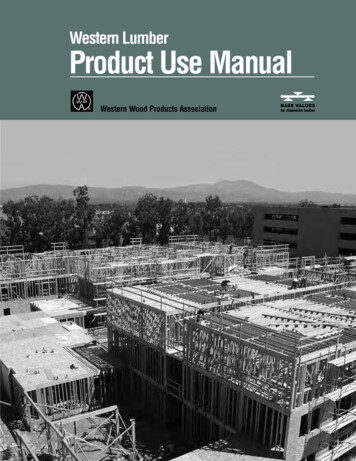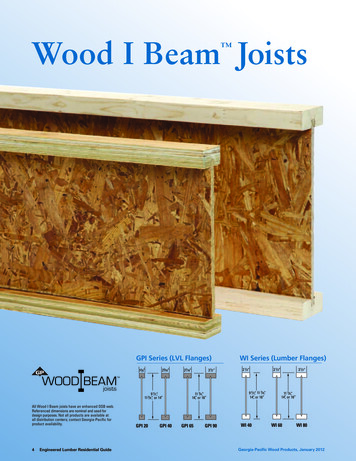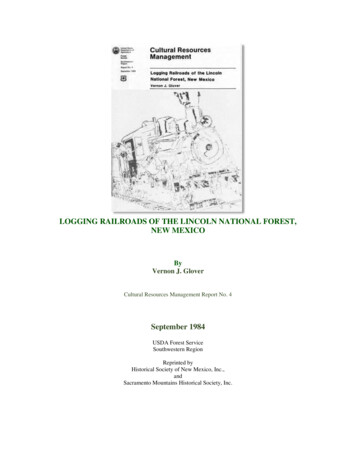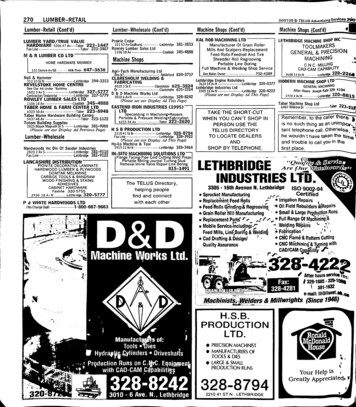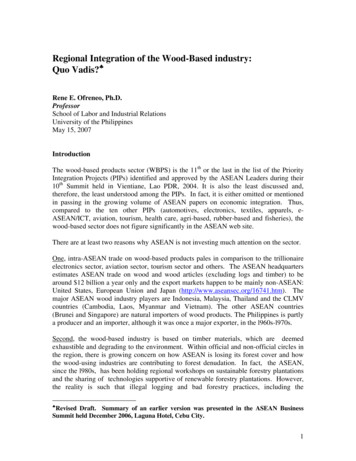
Transcription
Chapter 6Lumber Stress Grades andDesign PropertiesDavid E. Kretschmann and David W. GreenContentsResponsibilities and Standards for Stress Grading 6–2American Lumber Standard Committee 6–2National Grading Rule 6–3Standards 6–3Visually Graded Structural Lumber 6–3Visual Sorting Criteria 6–3Procedures for Deriving Design Properties 6–5Machine-Graded Structural Lumber 6–7Machine Sorting Criteria 6–7Procedures for Deriving Design Properties 6–8Quality Control 6–10Adjustment of Properties for Design Use 6–11Shrinkage 6–11Size Factor 6–11Moisture Adjustments 6–12Duration of Load 6–12Treatment Effects 6–13Temperature Effects 6–14References 6–14umber sawn from a log, regardless of species andsize, is quite variable in mechanical properties.Pieces may differ in strength by several hundredpercent. For simplicity and economy in use, pieces of lumberof similar mechanical properties are placed in categoriescalled stress grades, which are characterized by (a) one ormore sorting criteria, (b) a set of properties for engineeringdesign, and (c) a unique grade name.This chapter briefly discusses the U.S. Department of Commerce American Softwood Lumber Standard PS20 (1994)sorting criteria for two stress-grading methods, and the philosophy of how properties for engineering design are derived.The derived properties are then used in one of two designformats: (a) the load and resistance factor design (LRFD),which is based on a reference strength at the 5th percentile5-min bending stress (AF&PA 1996), or (b) the allowablestress design (ASD), which is based on a design stress at thelower 5th percentile 10-year bending stress. The propertiesdepend on the particular sorting criteria and on additionalfactors that are independent of the sorting criteria. Designproperties are lower than the average properties of clear,straight-grained wood tabulated in Chapter 4.From one to six design properties are associated with a stressgrade: bending modulus of elasticity for an edgewise loadingorientation and stress in tension and compression parallel tothe grain, stress in compression perpendicular to the grain,stress in shear parallel to the grain, and extreme fiber stressin bending. As is true of the properties of any structuralmaterial, the allowable engineering design properties must beeither inferred or measured nondestructively. In wood, theproperties are inferred through visual grading criteria, nondestructive measurement such as flatwise bending stiffness ordensity, or a combination of these properties. These nondestructive tests provide both a sorting criterion and a meansof calculating appropriate mechanical properties.The philosophies contained in this chapter are used by anumber of organizations to develop visual and machine stressgrades. References are made to exact procedures and theresulting design stresses, but these are not presented indetail.6–1
Responsibilities andStandards for Stress GradingAn orderly, voluntary, but circuitous system of responsibilities has evolved in the United States for the development,manufacture, and merchandising of most stress-graded lumber. The system is shown schematically in Figure 6–1.Stress-grading principles are developed from research findingsand engineering concepts, often within committees andsubcommittees of the American Society for Testing andMaterials.American LumberStandard CommitteeVoluntary product standards are developed under procedurespublished by the U.S. Department of Commerce. The Department of Commerce National Institute of Standards andTechnology (NIST), working with rules-writing agencies,lumber inspection agencies, lumber producers, distributorsand wholesalers, retailers, end users, and members of Federalagencies, work through the American Lumber StandardCommittee (ALSC) to maintain a voluntary consensussoftwood standard, called the American Softwood LumberStandard (PS 20–94). The PS 20–94 Standard prescribes theways in which stress-grading principles can be used toformulate grading rules designated as conforming to the(1) Formulation of stress grading principlesUniversity staff membersGovernment researchersIndustry R&D staffConsumer representatives(2) Product standardsAmerican Lumber Standard Committeeand its Board of ReviewNational Grading Rule CommitteeNational Institute of Standards and TechnologyReview and adoption(3) Formulation and publication ofstress-grading rulesRules-writing agencies(4) Grading agency accreditationAmerican Lumber Standard Committee(5) Grade mark supervision and reinspectionRules-writing agenciesIndependent inspection agencies(6) Manufacture and marketing of Americanstandard stress-graded lumberSawmillsFigure 6–1. Voluntary system of responsibilities forstress grading under the American Softwood LumberStandard.6–2American Lumber Standard. Under the auspices of the ALSCis the National Grading Rule, which specifies grading characteristics for different grade specifications.Organizations that write and publish grading rule bookscontaining stress-grade descriptions are called rules-writingagencies. Grading rules that specify American SoftwoodLumber Standard PS 20–94 must be certified by the ALSCBoard of Review for conformance with this standard.Organizations that write grading rules, as well as independent agencies, can be accredited by the ALSC Board ofReview to provide grading and grade-marking supervisionand reinspection services to individual lumber manufacturers.Accredited rules-writing and independent agencies are listedin Table 6–1. The continued accreditation of these organizations is under the scrutiny of the ALSC Board of Review.Most commercial softwood species manufactured in theUnited States are stress graded under American LumberStandard practice. Distinctive grade marks for each species orspecies grouping are provided by accredited agencies. Theprinciples of stress grading are also applied to several hardwood species under provisions of the American SoftwoodLumber Standard. Lumber found in the marketplace may bestress graded under grading rules developed in accordanceTable 6–1. Sawn lumber grading agenciesaRules-writing agenciesNortheastern Lumber Manufacturers Association(NELMA)Northern Softwood Lumber Bureau (NSLB)Redwood Inspection Service (RIS)Southern Pine Inspection Bureau (SPIB)West Coast Lumber Inspection Bureau (WCLIB)Western Wood Products Association (WWPA)National Lumber Grades Authority (NLGA)Independent agenciesCalifornia Lumber Inspection ServicePacific Lumber Inspection Bureau, Inc.Renewable Resource Associates, Inc.Timber Products InspectionAlberta Forest Products AssociationCanadian Lumbermen’s AssociationCanadian Mill Services AssociationCanadian Softwood Inspection Agency, Inc.Cariboo Lumber Manufacturers AssociationCentral Forest Products AssociationConiferous Lumber Inspection BureauCouncil of Forest Industries of British ColumbiaInterior Lumber Manufacturers AssociationMacDonald InspectionMaritime Lumber BureauNewfoundland Lumber Producers AssociationNorthern Forest Products AssociationOntario Lumber Manufacturers AssociationPacific Lumber Inspection BureauQuebec Lumber Manufacturers AssociationFor updated information, contact American LumberStandard Committee, P.O. Box 210, Germantown,MD 20874.a
with methods approved by the ALSC or by some otherstress-grading rule, or it may not be stress graded. Onlythose stress grades that meet the requirements of the voluntary American Softwood Lumber Standard system are discussed in this chapter.National Grading RuleStress grading under the auspices of the ALSC is applied tomany sizes and several patterns of lumber that meet theAmerican Softwood Lumber Standard provision. However,most stress-graded lumber is dimension lumber (standard 38to 89 mm (nominal 2 to 4 in.) thick) and is governed byuniform specifications under the National Grading Rule. TheNational Grading Rule provides guidelines for writing grading rules for lumber in this thickness range and specifiesgrading characteristics for different grade specifications.American Softwood Lumber Standard dimension lumber inthis thickness range is required to conform to the NationalGrading Rule, except for special products such as scaffoldplanks. Grade rules for other sizes, such as nominal 5-in.(standard 114-mm) or larger structural timbers may varybetween rules-writing agencies or species.The National Grading Rule establishes the lumber classifications and grade names for visually stress-graded dimensionlumber (Table 6–2) and also provides for the grading ofdimension lumber by a combination of machine and visualmethods. Visual requirements for this type of lumber aredeveloped by the respective rules-writing agencies forparticular species grades.Table 6–2. Visual grades described in NationalGrading RuleLumber classificationaGrade nameBendingstrengthratio (%)Light ct Structural123Structural light framingbStudcStructural joists and planksdSelect Structural1236755452665554526Contact rules-writing agencies for additional information.Standard 38 to 89 mm (nominal 2 to 4 in.) thick and wide.Widths narrower than 89 mm (4 in.) may have differentstrength ratio than shown.cStandard 38 to 89 mm (nominal 2 to 4 in.) thick, 38 mm ( 4 in.) wide.dStandard 38 to 89 mm (nominal 2 to 4 in.) thick, 140 mm ( 6 in.) wide.abStandardsTable 6–2 also shows associated minimum bending strengthratios to provide a comparative index of quality. Thestrength ratio is the hypothetical ratio of the strength of apiece of lumber with visible strength-reducing growth characteristics to its strength if those characteristics were absent.Formulas for calculating strength ratios are given in American Society of Testing and Materials (ASTM) standardD245. The corresponding visual description of the dimension lumber grades can be found in the grading rule books ofthe rules-writing agencies listed in Table 6–1. Design properties will vary by species. The design properties for eachspecies and grade are published in the appropriate rule booksand in the National Design Specification for WoodConstruction (AF&PA 1997).Grouping of SpeciesMost species are grouped together and the lumber from themtreated as equivalent. Species are usually grouped when theyhave about the same mechanical properties, when the woodof two or more species is very similar in appearance, or formarketing convenience. For visual stress grades, ASTMD2555 contains procedures for calculating clear wood properties for groups of species to be used with ASTM D245.ASTM D1990 contains procedures for calculating designproperties for groups of species tested as full-sized members.The properties assigned to a group by such procedures willoften be different from those of any species that make up thegroup. The group will have a unique identity, with nomenclature approved by the Board of Review of the ALSC. Theidentities, properties, and characteristics of individual speciesof the group are found in the grade rules for any particularspecies or species grouping. In the case of machine stressgrading, the inspection agency that supervises the gradingcertifies by testing that the design properties in that gradeare appropriate for the species or species grouping and thegrading process.Foreign speciesCurrently, the importation of structural lumber is governedby two ALSC guidelines that describe the application of theAmerican Lumber Standard and ASTM D1990 proceduresto foreign species. The approval process is outlined inTable 6–3.Visually GradedStructural LumberVisual Sorting CriteriaVisual grading is the original method for stress grading. It isbased on the premise that mechanical properties of lumberdiffer from mechanical properties of clear wood because manygrowth characteristics affect properties and these characteristics can be seen and judged by eye. Growth characteristics areused to sort lumber into stress grades. The typical visualsorting criteria discussed here are knots, slope of grain,6–3
Table 6–3. Approval process for acceptance of design values for foreign species123456789Rules-writing agency seeks approval to include species in grade-rule book.Agency develops sampling and testing plan, following American Lumber Standard Committee (ALSC) foreignimportation guidelines, which must then be approved by ALSC Board of Review.Lumber is sampled and tested in accordance with approved sampling and testing plan.Agency analyzes data by ALSC Board of Review and ASTM D1990 procedures and other appropriate criteria(if needed).Agency submits proposed design values to ALSC Board of Review.Submission is reviewed by ALSC Board of Review and USDA Forest Service, Forest Products Laboratory.Submission is available for comment by other agencies and interested parties.ALSC Board of Review approves (or disapproves) design values, with modification (if needed) based on allavailable information.Agency publishes new design values for species.checks and splits, shake, density, decay, heartwood andsapwood, pitch pockets, and wane.KnotsKnots cause localized cross grain with steep slopes. A verydamaging aspect of knots in sawn lumber is that the continuity of the grain around the knot is interrupted by the sawingprocess.In general, knots have a greater effect on strength in tensionthan compression; in bending, the effect depends on whethera knot is in the tension or compression side of a beam (knotsalong the centerline have little or no effect). Intergrown (orlive) knots resist (or transmit) some kinds of stress, butencased knots (unless very tight) or knotholes resist (ortransmit) little or no stress. On the other hand, distortion ofgrain is greater around an intergrown knot than around anencased (or dead) knot of equivalent size. As a result, overallstrength effects are roughly equalized, and often no distinction is made in stress grading between intergrown knots,dead knots, and knotholes.The zone of distorted grain (cross grain) around a knot hasless “parallel to piece” stiffness than does straight-grainedwood; thus, localized areas of low stiffness are often associated with knots. However, such zones generally constituteonly a minor part of the total volume of a piece of lumber.Because overall stiffness of a piece reflects the character ofall parts, stiffness is not greatly influenced by knots.The presence of a knot has a greater effect on most strengthproperties than on stiffness. The effect on strength dependsapproximately on the proportion of the cross section of thepiece of lumber occupied by the knot, knot location, anddistribution of stress in the piece. Limits on knot sizes aretherefore made in relation to the width of the face and location on the face in which the knot appears. Compressionmembers are stressed about equally throughout, and nolimitation related to location of knots is imposed. In tension,knots along the edge of a member cause an eccentricity thatinduces bending stresses, and they should therefore be more6–4restricted than knots away from the edge. In simply supported structural members subjected to bending, stresses aregreater in the middle of the length and at the top and bottomedges than at midheight. These facts are recognized in somegrades by differing limitations on the sizes of knots indifferent locations.Knots in glued-laminated structural members are not continuous as in sawn structural lumber, and different methodsare used for evaluating their effect on strength (Ch. 11).Slope of GrainSlope of grain (cross grain) reduces the mechanical propertiesof lumber because the fibers are not parallel to the edges.Severely cross-grained pieces are also undesirable becausethey tend to warp with changes in moisture content. Stressescaused by shrinkage during drying are greater in structurallumber than in small, clear straight-grained specimens andare increased in zones of sloping or distorted grain. To provide a margin of safety, the reduction in design propertiesresulting from cross grain in visually graded structural lumber is considerably greater than that observed in small, clearspecimens that contain similar cross grain.Checks and SplitsChecks are separations of the wood that normally occuracross or through the annual rings, usually as a result ofseasoning. Splits are a separation of the wood through thepiece to the opposite surface or to an adjoining surface causedby tearing apart of the wood cells. As opposed to shakes,checks and splits are rated by only the area of actual opening.An end-split is considered equal to an end-check that extendsthrough the full thickness of the piece. The effects of checksand splits on strength and the principles of their limitationare the same as those for shake.ShakeShake is a separation or a weakness of fiber bond, between orthrough the annual rings, that is presumed to extend lengthwise without limit. Because shake reduces resistance to shear
in members subjected to bending, grading rules thereforerestrict shake most closely in those parts of a bending member where shear stresses are highest. In members with limitedcross grain, which are subjected only to tension or compression, shake does not affect strength greatly. Shake may belimited in a grade because of appearance and because itpermits entrance of moisture, which results in decay.DensityStrength is related to the mass per unit volume (density) ofclear wood. Properties assigned to lumber are sometimesmodified by using the rate of growth and percentage of latewood as measures of density. Typically, selection for densityrequires that the rings per unit length and the percentage oflatewood be within a specified range. It is possible to eliminate some very low-strength pieces from a grade by excluding those that are exceptionally low in density.DecayDecay in most forms should be prohibited or severely restricted in stress grades because the extent of decay is difficultto determine and its effect on strength is often greater thanvisual observation would indicate. Decay of the pocket type(for example, Fomes pini) can be permitted to some extent instress grades, as can decay that occurs in knots but does notextend into the surrounding wood.Heartwood and SapwoodHeartwood does not need to be taken into account in stressgrading because heartwood and sapwood have been assumedto have equal mechanical properties. However, heartwood issometimes specified in a visual grade because the heartwoodof some species is more resistant to decay than is the sapwood; heartwood may be required if untreated wood will beexposed to a decay hazard. On the other hand, sapwood takespreservative treatment more readily than heartwood and it ispreferable for lumber that will be treated with preservatives.Pitch PocketsPitch pockets ordinarily have so little effect on structurallumber that they can be disregarded in stress grading if theyare small and limited in number. The presence of a largenumber of pitch pockets, however, may indicate shake orweakness of bond between annual rings.WaneWane refers to bark or lack of wood on the edge or corner ofa piece of lumber, regardless of cause (except eased edges).Requirements of appearance, fabrication, or ample bearing ornailing surfaces generally impose stricter limitations on wanethan does strength. Wane is therefore limited in structurallumber on those bases.Procedures for DerivingDesign PropertiesThe mechanical properties of visually graded lumber may beestablished by (a) tests of a representative sample of full-sizemembers (ASTM D1990 in-grade testing procedure) or(b) appropriate modification of test results conducted onsmall clear specimens (ASTM D245 procedure for smallclear wood). Design properties for the major commercialsoftwood dimension lumber species given in current designspecification and codes in the United States have been derived from full-size member test results. However, designproperties for most hardwood dimension and structural timbers (larger than standard 89-mm- (nominal 4-in.-, actual3-1/2-in.-) thick “timbers”) of all species are still derivedusing results of tests on small clear samples.Procedure for Small Clear WoodThe derivation of mechanical properties of visually gradedlumber was historically based on clear wood properties withappropriate modifications for the lumber characteristics allowed by visual sorting criteria. Sorting criteria that influence mechanical properties are handled with “strength ratios”for the strength properties and with “quality factors” for themodulus of elasticity.From piece to piece, there is variation in both the clear woodproperties and the occurrence of growth characteristics.The influence of this variability on lumber properties ishandled differently for strength properties than for modulus ofelasticity.Strength Properties—Each strength property of a piece oflumber is derived from the product of the clear wood strengthfor the species and the limiting strength ratio. The strengthratio is the hypothetical ratio of the strength of a piece oflumber with visible strength-reducing growth characteristicsto its strength if those characteristics were absent. The truestrength ratio of a piece of lumber is never known and mustbe estimated. Therefore, the strength ratio assigned to agrowth characteristic serves as a predictor of lumber strength.Strength ratio is expressed as a percentage, ranging from0 to 100.Estimated strength ratios for cross grain and density havebeen obtained empirically; strength ratios for other growthcharacteristics have been derived theoretically. For example,to account for the weakening effect of knots, the assumptionis made that the knot is effectively a hole through the piece,reducing the cross section, as shown in Figure 6–2. For abeam containing an edge knot, the bending strength ratio canbe idealized as the ratio of the bending moment that can beresisted by a beam with a reduced cross section to that of abeam with a full cross section:2( )SR 1 k/hwhere SR is strength ratio, k knot size, and h width of facecontaining the knot. This is the basic expression for the effectof a knot at the edge of the vertical face of a beam that isdeflected vertically. Figure 6–3 shows how strength ratiochanges with knot size according to the formula.6–5
khABFigure 6–2. Effect of edge knot: A, edge knot in lumberand B, assumed loss of cross section (cross-hatchedarea).Strength ratio (%)1008060402000.20.40.60.81.0k/hFigure 6–3. Relation between bending strength ratio andsize of edge knot expressed as fraction of face width.k is knot size; h, width of face containing the knot.Strength ratios for all knots, shakes, checks, and splits arederived using similar concepts. Strength ratio formulas aregiven in ASTM D245. The same reference contains guidelines for measuring various growth characteristics.An individual piece of lumber will often have several characteristics that can affect any particular strength property. Onlythe characteristic that gives the lowest strength ratio is usedto derive the estimated strength of the piece. In theory, avisual stress grade contains lumber ranging from pieces withthe minimum strength ratio permitted in the grade up topieces with the strength ratio just below the next highergrade. In practice, there are often pieces in a grade withstrength ratios of a higher grade. This is a result of gradereduction for appearance factors such as wane that do notaffect strength.The range of strength ratios in a grade and the natural variation in clear wood strength give rise to variation in strengthbetween pieces in the grade. To account for this variation andto ensure safety in design, it is intended that the actualstrength of at least 95% of the pieces in a grade exceed thedesign properties (before reduction for duration of load and6–6safety) assigned to that grade. In visual grading, according toASTM D245, this is handled by using a near-minimumclear wood strength as a base value and multiplying it by theminimum strength ratio permitted in the grade to obtain thegrade strength property. The near-minimum value is calledthe 5% exclusion limit. ASTM D2555 provides clear woodstrength data and gives a method for estimating the 5%exclusion limit.For example, suppose a 5% exclusion limit for the clearwood bending strength of a species in the green conditionis 48 MPa (7,000 lb/in2). Suppose also that among thecharacteristics allowed in a grade of lumber, one characteristic(a knot, for example) provides the lowest strength ratio inbending—assumed in this example as 40%. Using the numbers, the bending strength for the grade is estimated bymultiplying the strength ratio (0.40) by 48 MPa(7,000 lb/in2), equaling 19 MPa (2,800 lb/in2) (Fig. 6–4).The bending strength in the green condition of 95% of thepieces in this species in a grade that has a strength ratio of40% is expected to be 19 MPa ( 2,800 lb/in2). Similarprocedures are followed for other strength properties, usingthe appropriate clear wood property value and strength ratio.Additional multiplying factors are then applied to produceproperties for design, as summarized later in this chapter.Modulus of Elasticity—Modulus of elasticity E is a measure of the ability of a beam to resist deflection or of a columnto resist buckling. The assigned E is an estimate of theaverage modulus, adjusted for shear deflection, of the lumbergrade when tested in static bending. The average modulus ofelasticity for clear wood of the species, as recorded in ASTMD2555, is used as a base. The clear wood average is multiplied by empirically derived “quality factors” to represent thereduction in modulus of elasticity that occurs by lumbergrade for pieces tested in an edgewise orientation. Thisprocedure is outlined in ASTM D245.For example, assume a clear wood average modulus of elasticity of 12.4 GPa (1.8 106 lb/in2) for the example shownearlier. The limiting bending strength ratio was 40%.ASTM D245 assigns a quality multiplying factor of 0.80for lumber with this bending strength ratio. The modulusof elasticity for that grade would be the product of the clearwood modulus and the quality factor; that is,12.4 0.8 9.9 GPa (1.8 0.8 1.44 106 lb/in2).Actual modulus of elasticity of individual pieces of a gradevaries from the average assumed for design (Fig. 6–5). Smallindividual lots of lumber can be expected to deviate from thedistribution shown by this histogram. The additional multiplying factors used to derive final design values of modulusof elasticity are discussed later in this chapter.In-Grade ProcedureTo establish the mechanical properties of specified grades oflumber from tests of full-size specimens, a representativesample of the lumber population is obtained following procedures in ASTM D2915 and D1990. The specimens aretested using appropriate procedures given in ASTM D198
640304202102004060Strength ratio (%)010080Expected bending strength (x103 lb/in2)Expected bending strength (MPa)8Clear wood 5% exclusion limit50Figure 6–4. Example of relation between strengthand strength ratio.Frequency (%)20Machine-GradedStructural LumberMachine-graded lumber is lumber evaluated by a machineusing a nondestructive test followed by visual grading toevaluate certain characteristics that the machine cannot ormay not properly evaluate. Machine-stress-rated (MSR),machine-evaluated-lumber (MEL), and E-rated lumber arethree types of machine-graded lumber. Machine-graded lumber allows for better sorting of material for specific applications in engineered structures. The basic components of amachine-grading system are as follows:1.sorting and prediction of strength through machinemeasured nondestructive determination of propertiescoupled with visual assessment of growth characteristics,2.assignment of design properties based on strengthprediction, and3.quality control to ensure that assigned properties arebeing obtained. The quality control procedures ensurea. proper operation of the machine used to make thenondestructive measurements,1612b. appropriateness of the predictive parameter–bendingstrength relationship, and8c. appropriateness of properties assigned for tensionand )15.17(2.2)17.93(2.6)Modulus of elasticity in edgewise bending(GPa (x106 lb/in2))Figure 6–5. Histogram of modulus of elasticityobserved in a single visual grade, from piecesselected over a broad geographical range.or D4761. Because the range of quality with any one specificgrade may be large, it is necessary to assess the grade qualityindex (GQI) of the sampled material in relation to theassumed GQI. In the North American In-Grade Program,GQI was the strength ratio calculated according to formulasin ASTM D245. The sample GQI and the assumed GQI arecompared to see if adjustment to the test data is necessary.An average value for the edgewise modulus of elasticity or anear-minimum estimate of strength properties is obtainedusing ASTM D1990 procedures. The grade GQI is also usedas a scaling perimeter that allows for modeling of strengthand modulus of elasticity with respect to grade. These properties are further modified for design use by consideration ofservice moisture content, duration of load, and safety.The MSR and MEL systems differ in grade names, qualitycontrol, and coefficient of variation (COV) for E values.Grade names for MSR lumber are a combination of thedesign bending stress and average modulus of elasticity,whereas grade names for MEL lumber start with an M designation. For quality control, MSR requires pieces to be testeddaily for at least one strength property and bending modulusof elasticity in an edgewise orientation, whereas MEL requires daily tension quality control and edgewise bendingstrength and stiffness testing. Finally, MSR grades areassigned a COV 11% on E, whereas MEL grades areassigned a COV 15% on E. Grade names for a wide rangeof machine-graded lumber commonly available across NorthAmerica are given in Table 6–4. Not all grades are availablein all sizes or species.Machine Sorting CriteriaThe most common method of sor
Stress grading under the auspices of the ALSC is applied to many sizes and several patterns of lumber that meet the American Softwood Lumber Standard provision. However, most stress-graded lumber is dimension lumber (standard 38 to 89 mm (nominal 2 to 4 in.) thick) and is governed by uniform specifications under the National Grading Rule. The
